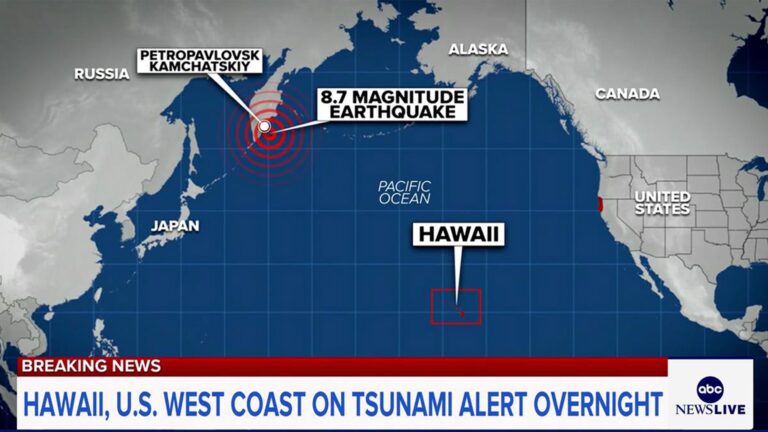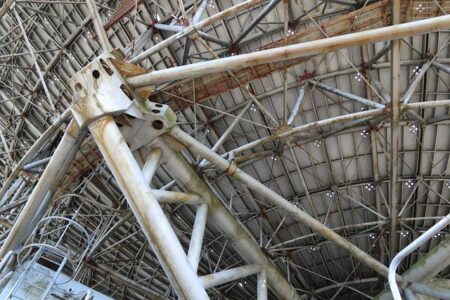A powerful 8.8-magnitude earthquake struck offshore, triggering small tsunamis that reached the coasts of Russia, Japan, and Alaska, according to official reports. The seismic event, one of the strongest in recent years, prompted immediate warnings and ongoing monitoring as authorities assess potential damage and risks to affected communities. This developing situation highlights the persistent seismic activity in the Pacific Rim, emphasizing the importance of preparedness in these vulnerable regions.
Massive Earthquake Triggers Tsunami Waves Along Russia Japan and Alaska Coasts
In the early hours today, a powerful 8.8-magnitude earthquake struck beneath the Pacific Ocean, setting off a series of tsunami alerts along the coastal regions of Russia, Japan, and Alaska. Authorities reported swift but moderate tsunami waves reaching shorelines, prompting emergency responses and precautionary evacuations in vulnerable areas. Despite the intensity of the seismic event, initial assessments indicate limited structural damage and no immediate reports of casualties. Agencies continue to monitor aftershocks and oceanographic data closely to ensure public safety.
Key impacts observed so far include:
- Remote coastal villages: Experienced temporary flooding and minor disruptions to fishing activities.
- Transportation hubs: Temporary closures of ports in Hokkaido and the Aleutian Islands to assess harbor conditions.
- Emergency alerts: Issued promptly across affected regions, ensuring rapid dissemination of safety instructions.
| Region | Max Wave Height | Response Status |
|---|---|---|
| Russia (Kamchatka) | 0.8 meters | Advisory issued |
| Japan (Hokkaido) | 1.1 meters | Evacuation in select areas |
| Alaska (Aleutians) | 0.9 meters | Monitoring ongoing |
Emergency Response Efforts Mobilize to Assess Damage and Protect Coastal Communities
Authorities across Russia, Japan, and Alaska have rapidly deployed emergency teams to the affected coastal regions after the 8.8-magnitude earthquake triggered a small tsunami. Immediate assessment efforts are focused on identifying structural damages, disrupted communications, and potential secondary hazards such as landslides or flooding. Emergency operation centers have been activated to coordinate rescue missions, with specialists utilizing aerial surveys and drone technology to expedite damage evaluations in remote and hard-hit areas.
Key response actions include:
- Evacuation of vulnerable coastal populations to pre-designated safe zones
- Swift restoration of critical infrastructure such as power grids and communication lines
- Deployment of medical units and supply distribution teams to impacted communities
- Continuous monitoring of tsunami warning systems for potential follow-up waves
| Region | Emergency Teams Deployed | Primary Focus |
|---|---|---|
| Russia (Kamchatka) | 120 personnel | Infrastructure assessment |
| Japan (Tohoku) | 300 personnel | Evacuation and medical aid |
| Alaska (Aleutian Islands) | 85 personnel | Damage reconnaissance & supply delivery |
Experts Urge Preparedness and Updated Evacuation Plans Amid Increasing Seismic Activity
Seismologists and disaster management experts emphasize the urgent need for communities along the Pacific Rim to reevaluate their current emergency response strategies. The recent 8.8-magnitude earthquake, which triggered a minor tsunami affecting the coasts of Russia, Japan, and Alaska, has highlighted vulnerabilities in local evacuation frameworks. Authorities are encouraged to integrate real-time seismic monitoring with public alert systems to enhance early warning capabilities. Additionally, experts advise revising evacuation routes and shelters regularly to ensure accessibility and safety during sudden evacuations.
Community leaders and residents alike are urged to participate actively in preparedness drills and familiarize themselves with updated protocols. Key recommendations include:
- Regularly updated evacuation maps distributed through multiple communication channels;
- Installation of additional tsunami warning sirens in vulnerable coastal areas;
- Periodic review and maintenance of critical infrastructure to withstand both earthquakes and ensuing tsunamis;
- Community awareness programs about emergency supplies and safety measures.
| Safety Measure | Importance Level | Implementation Status |
|---|---|---|
| Evacuation Route Signage | High | Partial |
| Emergency Supply Kits | Medium | Ongoing |
| Seismic Sensor Networks | Critical | Expanding |
| Community Drills | High | Planned |
Closing Remarks
As rescue and assessment efforts continue along the affected coastlines of Russia, Japan, and Alaska, authorities urge residents to remain vigilant and follow safety protocols in the wake of the 8.8-magnitude earthquake and resulting tsunami. While initial reports indicate limited damage, emergency services are actively monitoring the situation to respond to any emerging needs. Updates will be provided as more information becomes available.




